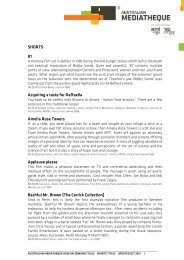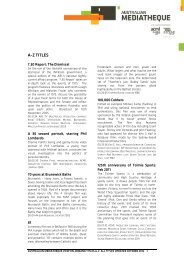Tim Burton's Gothic Imagination
Tim Burton's Gothic Imagination
Tim Burton's Gothic Imagination
You also want an ePaper? Increase the reach of your titles
YUMPU automatically turns print PDFs into web optimized ePapers that Google loves.
ight red blood. The theatricality and excess of the Hammer horror film tradition allies it<br />
with the extreme style of performance that was the trademark of the Grand Guignol theatre<br />
in Paris. 16 <strong>Tim</strong> Burton’s bloodiest films Sleepy Hollow and Sweeney Todd are very much a part<br />
of this tradition.<br />
Although Hammer made its own contribution to the horror film genre and marked a clear<br />
break from the black and white Expressionist-style films of the 1930s, it also drew on <strong>Gothic</strong><br />
classics like Frankenstein, Dracula and Dr Jekyll and Mr Hyde. Around the same time, Roger<br />
Corman of the low budget studio American International Pictures made a series of horror<br />
films based on the stories of Edgar Allan Poe, the eight titles included: House of Usher<br />
(1960), The Pit and the Pendulum and The Tomb of Ligeia (1965). House of Usher, the first in<br />
the series, stood out from previous films made by the studio due to the lavish sets and the<br />
general opulence of the production. These films were popular on first release but have<br />
probably become embedded in our shared cultural memory due to their frequent TV<br />
screenings.<br />
As a child and teenager, <strong>Tim</strong> Burton was an avid TV viewer who also revelled in the triple bills<br />
that were a feature of Saturday afternoons in Burbank during this period. Feeling stifled by<br />
the conformism and banality of the Burbank milieu, Burton escaped into the imaginative<br />
worlds offered by these low budget horror and monster films.<br />
Vincent Price, Edgar Allan Poe, those monster movies, those spoke to me. You see<br />
somebody going through that anguish and that torture – things you identify with –<br />
and it acts as a kind of therapy, a release. – <strong>Tim</strong> Burton 17<br />
As well as responding to these films for their capacity to take him into another world that<br />
was so different from the one he was trying to survive while growing up, Burton was also<br />
inspired by the visual artistry of these works. The ornate <strong>Gothic</strong> excess of these films in<br />
combination with the hand-made, artificiality of their mise-en-scène have fed into Burton’s<br />
own work and its determined rejection of narrative realism.<br />
FREE FOR EDUCATION Education Resources <strong>Tim</strong> Burton’s <strong>Gothic</strong> <strong>Imagination</strong> 9










